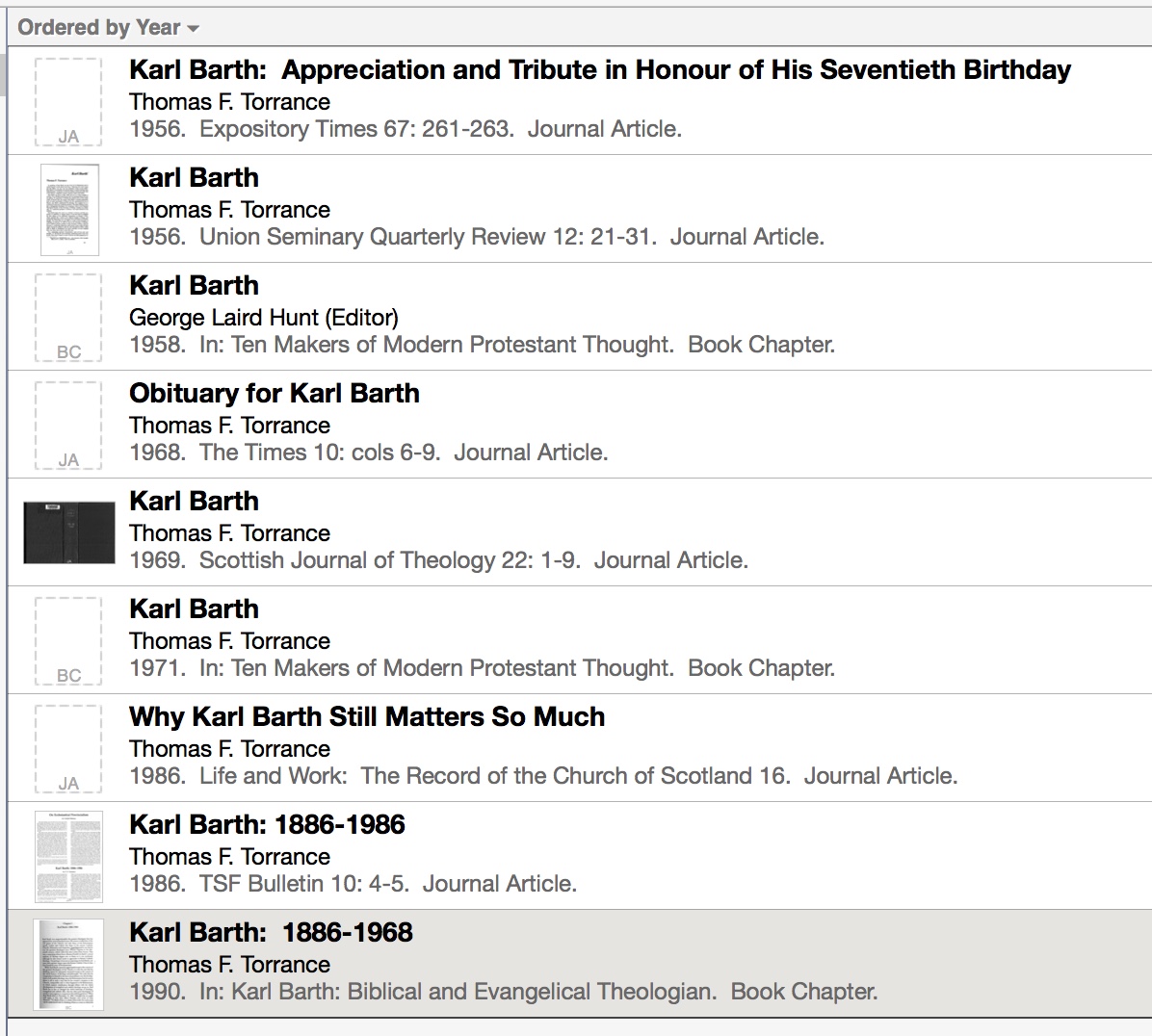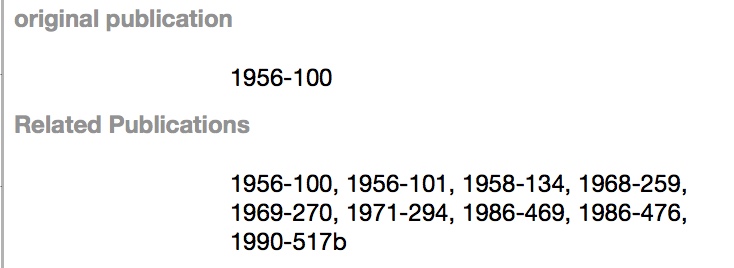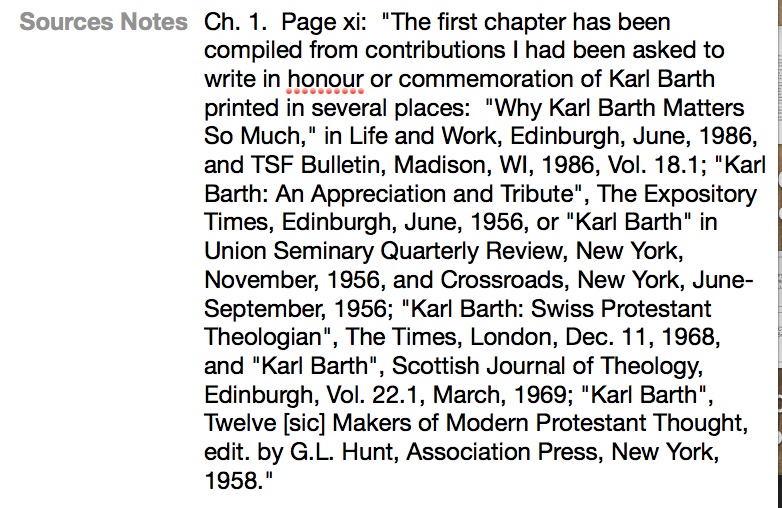Sources | Studies | Member Publications | Book Reviews | Recent | Online | Combined | Bib FAQ | McGrath# FAQ | Sources by McGrath# | Sources with New McGrath#s |
We thank Alister McGrath for permission to base the Sources bibliography on the most comprehensive and authoritative bibliography to date, published in T. F. Torrance: An Intellectual Biography (1999). In the Sources bibliography, 633 "McGrath numbers" are indicated for each item as assigned in McGrath's biography. New "McGrath numbers" are created for items not included there (e.g., #1999-AEM-1 for McGrath's biography).
McGrath# Status update:
Although McGrath#'s are present on every bibliographic record, the website's Advanced Search functionality is not yet implemented. One of our top priorities for website development in 2020 will be to support the advanced searches that could be performed using offline software as described on The Bibliographies as a Research Tool page. General search, as now implemented, cannot perform all of these searches. Screenshots below were made using that offline bibliographic software; they will be updated once Advanced Search becomes available here on the website.
Find by #:
To quickly go to a record if you know its McGrath #, use the Find by # bar in the footer. Cf. instructions in the Search section of the Tutorial.
View all Sources by McGrath #: /mcgrath
How are McGrath numbers formatted?
-- The first principle is that no original McGrath numbers are changed, so use of the printed edition of McGrath's biography is unaffected by the new numbering system. Original McGrath numbers were identified as integers from 1 to 633.
-- McGrath organized the numbers in chronological order, interspersing dates as headings. For convenience, on this website dates have been prefixed to the original McGrath number, as follows: "1961-176."
-- If a record is split into separate items, then the McGrath number is followed by "a," "b," etc. for individual chapters or sections of a work. For example, 1995-588f is a chapter of the book with the original McGrath number of 588.
How are new McGrath numbers formatted for Sources?
-- Sources with new McGrath #'s (list)
-- Source entries with new McGrath numbers are tagged "New McGrath number."
-- The supplemental numbering system is open-ended to accommodate new publications in an ongoing manner. Each supplemental number consists of the following components, in order, separated by hyphens:
* The date of publication appears first.
* Author initials appear next (e.g., -TFT, -JBT- or -DWT-). The presence of author initials thus indicates that the item was not in McGrath's original printed bibliography. If no author initials appear (e.g., 1961-176), then the publication is by TFT, was included in the printed McGrath bibliography, and the number after the date is the original McGrath number.
* When an author has published multiple items in the same year, items by that author within that year are incremented by integers; e.g. "2008-TFT-1", "2008-TFT-2" etc. and then resetting to "1" the following year as "2009-TFT-1", "2009-TFT-2" etc. and so on.
* If a publication is split into separate chapters by the same author, then the McGrath number is followed by "a," "b," etc. for individual chapters or sections of the work. For example, 2008-TFT-2a is a chapter of the book with the supplemental McGrath number of 2008-TFT-2.
How are ID#'s created for Studies?
• Studies have ID#'s that resemble the McGrath#'s. In general, the initials of any author make up their own Person ID, e.g., GWD. That Person ID serves as the middle portion of any Studies ID. For example, 2020-GWD-1 would be the Studies ID for the first publication by Gary W. Deddo to appear in 2020.
• The Person ID is entered in the ID# field of a Profile page. It is also the last term in the url for the Profile page. For example, /GWD is the web address for Gary Deddo's profile. To set the url of the Profile page accordingly, the Person ID is entered in the "URL alias" field located in the right margin. In the "URL Alias" field, it needs to be preceded by a slash, such as "/GWD". Once entered in the "URL Alias" field, the ID will become the last term of the url for the person's profile.
Do you recommend including the "McGrath number" in a citation to a Torrance publication?
When a large number of publications exist, many of them similar and easily mistaken for one another, referring to a publication's number according to a standard catalog removes any ambiguity about which publication is meant. For example, any work by Charles Darwin may be referred to according to its "Freeman number," or any work by Johannes Kepler may be specified by its "Caspar number." In the case of Thomas F. Torrance, given the variations that appear in reprints and editions, even those published during Torrance's lifetime, there is no better way to unambiguously specify which Torrance publication one intends than to refer to its McGrath number.
Why search by McGrath number?
Perhaps the most obvious way to find related publications is to search for a key word from the title, as described above. Key word searches may fail to catch related publications in other languages or related items with rephrased titles. Words may have variant spellings (does one search for "Saviour" or "Savior"?). Book titles or journal names may not be entered on a related record when published elsewhere. A key word search may also turn up extraneous items that share the same word but are actually not directly related in a derivative sense.
Tip: Search by McGrath number rather than by key words.
How does a search by McGrath number work with the "Related Sources" field?
Suppose you want to find publications related to Space, Time and Incarnation. A search by its McGrath number ("1969-262") yields a dozen results, including a Chinese translation, and a 1974 article which Torrance described as a "companion" to the first chapter of Space, Time and Incarnation ("The Relation of the Incarnation to Space in Nicene Theology").
Screenshot - McGrath numbers in a "Related Sources" field:
This search takes advantage of a "Related Sources" field, which contains the McGrath numbers of publications that are related to the current record in an explicit or derivative manner. These might be earlier or later editions of the work, including versions of the work published as conference presentations or recorded in audio or video, or incorporated into larger works with different titles. (The nature of the relationships may be explained in the "Publication Life Cycle / Notes" field.) Searching by a McGrath number is thus a more precise and more powerful alternative to a key word search. Searching by the McGrath number will expand a key word search to catch related publications with different titles, and will narrow down a key word search by omitting items which are not actually part of a work's publication history.
How about another example?
Consider the first chapter of "Karl Barth: 1886-1968," in Karl Barth: Biblical and Evangelical Theologian (Edinburgh: T&T Clark, 1990), 1-26; #1990-517b. A key word search for "Barth" will turn up many hits, perhaps too many to be manageable.
To investigate the publication history of this chapter, search instead for its McGrath number, "1990-517b." This search yields 9 results, ranging from 1956 to 1986.
Screenshot - 9 results for "1990-517b":
McGrath numbers for these 9 sources are listed in the "Related Sources" field.
Screenshot - McGrath numbers in the "Related Sources" field for "Karl Barth: 1886-1968" (1990):
A description of the relations between the 9 publications appears in the "Publication Life Cycle/Notes" field.
Screenshot - Explanation in the "Publication Life Cycle / Notes" field for "Karl Barth: 1886-1968" (1990):
In many cases, searching by McGrath number offers an easy and powerful complement to key word searches.
How will a list sort by McGrath number?
First, for any given year, records with original McGrath numbers will be listed first, followed by those with supplemental McGrath numbers. The latter are in turn grouped by author.
- ...
- 1984-433
- 1984-433a
- 1984-433b
- 1984-434
- 1984-JBT-1
- 1984-TFT-1
- ...
Or:
- ...
- 1984-433 (An original McGrath number)
- 1984-433a (Chapter of the book)
- 1984-433b (Chapter of the book)
- 1984-434 (Another original McGrath number)
- 1984-JBT-1 (By James Torrance with a supplemental number)
- 1984-TFT-1 (By Thomas Torrance with a supplemental number)
- ...
Second, within the subgroup of any author's publications for a given year, chapters will follow the books that contain them:
- ...
- 1965-TFT-1
- 1965-TFT-1a
- 1965-TFT-1b
- 1965-TFT-1c
- 1965-TFT-2
- 1965-TFT-2a
- 1965-TFT-2b
- 1965-TFT-2c
- ...
Which ones are books and which ones are chapters? It is easy to tell at a glance:
- ...
- 1965-TFT-1 (Book 1)
- 1965-TFT-1a (Chapter of Book 1)
- 1965-TFT-1b (Chapter of Book 1)
- 1965-TFT-1c (Chapter of Book 1)
- 1965-TFT-2 (Book 2)
- 1965-TFT-2a (Chapter of Book 2)
- 1965-TFT-2b (Chapter of Book 2)
- 1965-TFT-2c (Chapter of Book 2)
- ...
List of all records by McGrath #.
Send new materials, corrections, and comments to the bibliography editors using the Webmaster contact form. Also let us know if you can provide or verify any item on our Wanted List.
- 198 views
